Cover image: Argivian Archaeologist by Amy Weber
The Brothers’ War is almost upon us, nearly 30 years since the event it features first became part of Magic’s world in 1994’s Antiquities. As early sets go, Antiquities was astoundingly full of lore and flavor, drawing the players into the world of Dominia once again, after receiving their first glimpse the previous year.
While the initial foray in Limited Edition introduced the players as planeswalkers sojourning and dueling other planeswalkers among the lands of Benalia, Llanowar, Keld, Shiv, this time our players arrive and learn about the plane alongside archaeologists unearthing clues about a cataclysmic war in the world’s ancient past, sages poring over ancient tomes to divine the secrets of long-departed master artificers, elemental spirits still shaped by the worldwide trauma the ancient war caused, and the horrifying servants of the phyrexians. The back of the booster packs invites us into their excavations:
“Long ago, two wizards battle for control of Dominia. Now Antiquities unearths the relics of this ancient rivalry: over seventy-five artifacts and spells that shaped the five magics and altered Dominia forever. . . .unleash the power of the past!”
Coming after the broad and atmospheric style of Limited Edition and Arabian Nights, Antiquities was the first Magic set to tell a focused story. While later sets would take players on skyship journeys and into pit fights while they were happening, with accompanying fiction to help make sense of the world’s events; Antiquities finds us arriving centuries later, helping a healing world piece together clues about its own past, and tempting us to wield once-forgotten spells and artifice to overcome our future opponents.
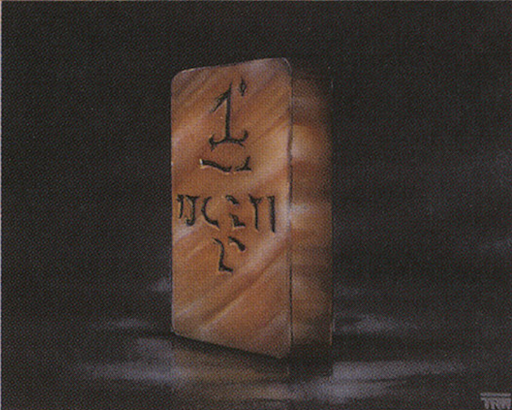
Bronze Tablet by Tom Wänerstrand.
Released as it was, without any immediately accompanying Magic fiction (that would come a few years later), players of Antiquities were thrust into the story themselves, an echo of the sages or archaeologists uncovering the wreckage of the Thran Empire, left to discern the events of Dominian history from disordered fragments which we find on the cards. And so the question emerges: What kind of history of the Brothers’ War emerges from just these fragments alone?
You may be wondering, at this point, why in the world you should care, or why in the world am I spending my time sharing this intellectual exercise with you. Thank you for asking; I will tell you: This is what historians and archaeologists other scholars of the ancient world are doing all the time! The study of the distant past takes place through attending to preserved manuscripts, monuments, and artifacts, none of which can by themselves or in conjunction with anything else provide us with a full understanding of a time that is not our own or persons that have long since left the world.
We (unless we’re Teferi or The Doctor) cannot go back in time and see for ourselves. Ultimate certainty is beyond us, but better or worse answers can be given, and Antiquities puts the players in this role as a way of immersing them in the game world, providing a layer of potential depth in the fantasy cardgame that surpassed a merely aesthetic appreciation for fantasy art and enjoyable gameplay. One sees the gameworld’s own history unfolding in a way much like the characters in it would see it. Of course, one could just skim the cards for their function, choosing optimally from the new set—but for the Vorthoi out there, there was the possibility of going deeper in a new way.
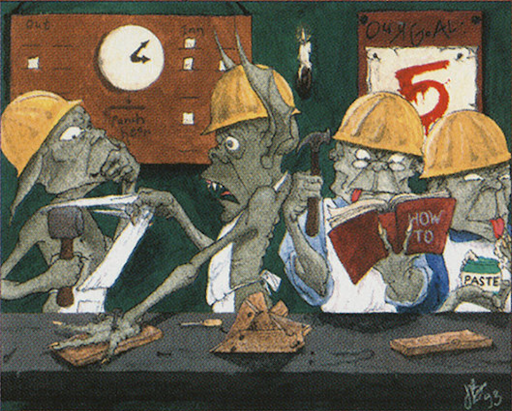
Goblin Artisans by Julie Baroh
In this article, I take a look at the story that emerges on the flavor text of cards from Antiquities as an exercise in textual interpretation, with an occasional reference to the art or the names of cards without flavor text. In a perfect world, there would be time and space to look at all the art as well, but I will leave that to you, or to others, to do for yourself. With that said, let’s dive into the text:
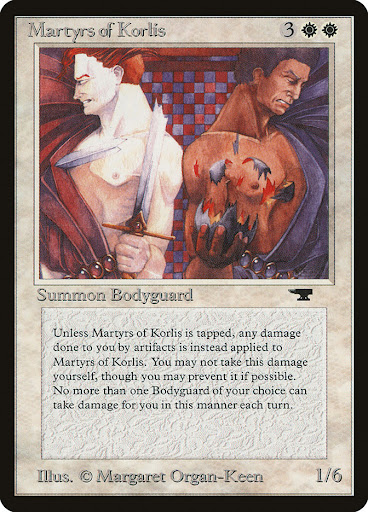
White (Argive)
The color white focuses on the nation of Argive and their work in uncovering the past. On Argivian Archaeologist, we read:
“Fascinated by the lore of ancient struggles, the Archaeologist searches incessantly for remnants of an earlier, more powerful era.”
On Argivian Blacksmith, we learn:
“Through years of study and training, the Blacksmiths of Argive became adept at reassembling the mangled remains of the strange, mechanical creatures abounding in their native land.”
The spirit of discovery is alive here, but there is something of a spirit of dread accompanying the text, the idea, perhaps that these archaeologists and blacksmiths may be meddling in something that was at one time tremendously dangerous. Along with Artifact Ward and Circle of Protection: Artifacts, Damping Field suggest that the function of these machines was something to be suppressed:
Eventually, mages learned to harness the power of natural damping fields and use it for their own ends.
And the presence of Martyrs of Korlis tells us that magical means may not always have been enough. From these scraps of text alone, it isn’t clear when the Argivian Archaeologist is working. Is the Argivian Archaeologist in the “present,” excavating the ruins of The Brothers’ War? Or in the past, excavating another, earlier conflict? To players in 1994, this was uncertain.
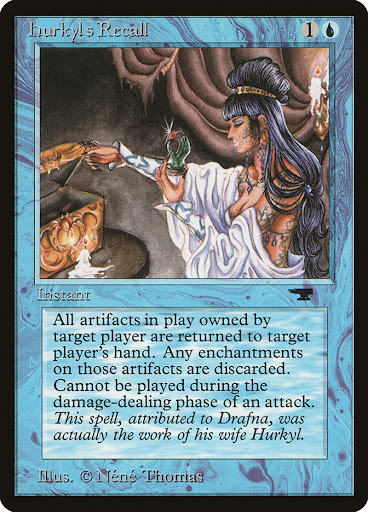
Blue (The College of Lat-Nam)
From the blue cards in Antiquities, we learn primarily about who Drafna, Hurkyl, and the College of Lat-Nam are: brilliant wizards who used magic to reconstruct or unmake ancient artifacts. It is said on Drafna’s Restoration:
“Drafna, founder of the College of Lat-Nam, could create a working model from even the smallest remnants of a newly unearthed artifact.”
Furthermore, Drafna’s disciples followed his work closely, as written on Reconstruction:
“Tedious research made the Sages of the College of Lat-Nam adept in repairing broken artifacts.”
We also catch a glimpse of the redaction of historical narratives, uncovering and correcting implicit gender-bias, in the commentary on Hurkyl’s Recall:
This spell, attributed to Drafna, was actually the work of his wife Hurkyl.
This remark on authorship, which I imagine as a kind of footnote or aside in a list of spells or book of discourse on the magical research of Lat-Nam, is common enough in ancient texts, where anonymous and pseudonymous authorship was frequent. The blue cards give us a sense of the immense prowess of these mages, but at the same time, in light of the white cards, we may wonder if these skills are necessarily a good thing.
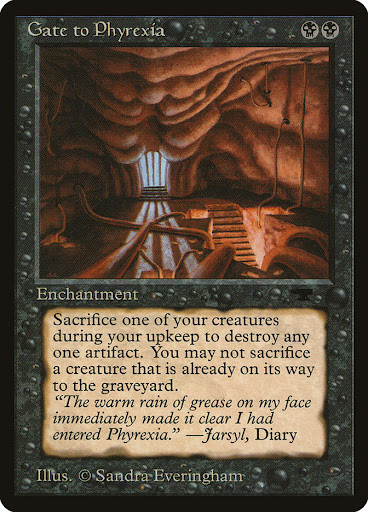
Black (Phyrexia)
Black cards give us a look into the facility of black magic and artifice, and especially at the realm of Phyrexia. Haunting Wind and Xenic Poltergeist portray the interaction with spirits with human artifice, and Artifact Possession gives us a look at how this may come to happen:
“Any black mage could coax a Thraxodemon to inhabit a magical device.”
A thraxodemon, as the name implies, is a spirit (daemon) that “stirs” or “troubles” (thrax / thrasso). The black mages on Dominia are utilizing spirits to “haunt” weapons of war, both to afflict enemies’ use of them, and perhaps to animate their own mechanical war engines. Thanks to a recovered journal, it is also known that at least one mage journeyed beyond Dominia to the plane of Phyrexia:
“The warm rain of grease on my face immediately made it clear I had entered Phyrexia.” —Jarsyl, Diary
Whether these black mages are with the Phyrexians or not is unclear, but it is known that Phyrexia is of interest, and consumes or uses artifice for its power, as depicted on Yawgmoth Demon and Priest of Yawgmoth.
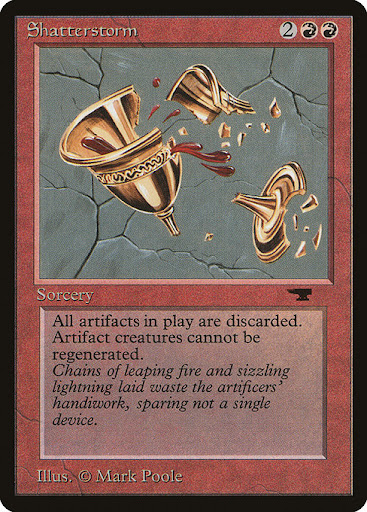
Red (Mountaindwellers)
Whereas some colors in Antiquities seem to be located in both an ethos and a faction, red seems focused on the ethos of destruction. Artifacts must to be destroyed if the war is to be survived, and the cards with flavor text give us a look at very limited initial successes:
“The first line of defense against Urza and Mishra, the Artifact Blast achieved widespread fame until an unlucky mage discovered it was useless on the devices the brothers had already created.”
And more widespread devastation, with the spells Detonate and Shatterstorm:
Chains of leaping fire and sizzling lightning laid waste the artificers’ handiwork, sparing not a single device.
Thus far, we’ve seen the war waged on techno-magical terms. The power of wizards to ward off, reconstruct, destroy, or even “haunt” artifice conveys a world where even the practice of magic has been warped around the ever-looming threat of powerful artifice. Few colors make this clearer than green.
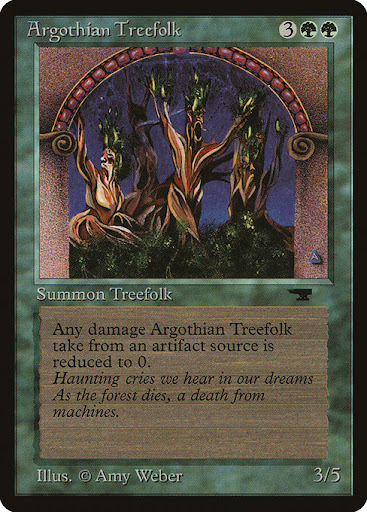
Green (Argoth)
The green cards of Antiquities are unanimous in their story. Argothian Pixies, Argothian Treefolk, Citanul Druids, Crumble, Gaea’s Avenger, and Powerleech, tell the same story, over and over: a once verdant and peaceful forest forever changed by the abuse of their natural resources.
After the rape of Argoth Forest during the rule of the artificers, the Pixies of Argoth bent their magic to more practical ends.
Haunting cries we hear in our dreams / As the forest dies, a death from machines.
Driven mad by the fall of Argoth, the Citanul Druids found peace only in battle.
The spirits of Argoth grant new life to those who repent the folly of enslaving their labors to devices.
After the destruction of Argoth, Gaea was willing to instill a portion of her own powers into some of her more vengeful followers.
The Forest of Argoth has developed a resistance to mechanical intrusion.
In some, the colored cards of Antiquities tell of the world rediscovering a past that nature has yet to forget. While the white and blue archaeologists and sages seem interested in reconstruction and learning from these ancient treasures, the air of caution, or even foreboding, seen on cards like Artifact Ward and Damping Field is thrown to the wind in black and red, who seem to be willing to exploit, curse, or destroy artifacts as it suits them. Only the denizens of Argoth seem to have a long enough memory to fully oppose artifice at this stage.
At this stage in our excavation, what do we know? Working backwards, we know that Argoth was once ravaged by artificers. The timing is uncertain, but we have a sense that after the fall, the former denizens adapted to oppose artifice in particular. We know that Urza and Mishra were people to be defended against, and that the spell, Artifact Blast met with some initial success, but had its limitations.
We learn that black mages consorted with demons and spirits, using them to meddle with artifice, and that Phyrexia is a realm where it rains warm grease. The sages of Lat-Nam seemed to have been adept at fabricating working copies of artifacts or repairing them, and spiriting them away into aether. Likewise, the Argivians seemed fascinated by them, excavating and repairing them, but also developing ways of protecting themselves from them.
Here we have only scraps of a third of the set, and we can say that the world of Antiquities is a world shaped by its relationship to artifice, and that the relationship is cautious at best, but overall quite hostile. The characters of Urza and Mishra have been named, but it is unclear who they are and why they need to be defended against, though we can deduce they are using works of artifice offensively.
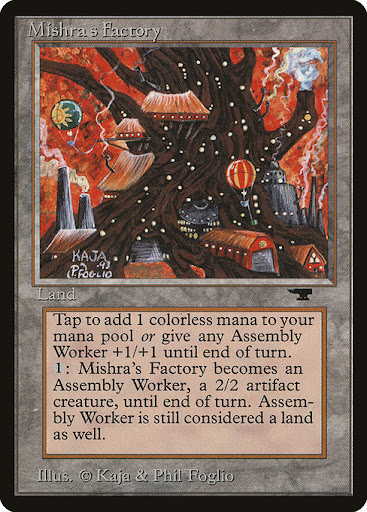
In my next foray into the flavor text of Antiquities, I’ll be looking at the rest of the set: the artifacts and lands, to see what they can tell us about the events of Brothers’ War and how the text there might help us to better locate ourselves in time, and help us to dig up what we’ve been unable to mine thus far. Until next time.
Jacob W. Torbeck, Ph.D. (he/him) is a researcher and lecturer in philosophy and theology. Jacob hails from the Greater Chicago area, and loves playing Commander and Limited Magic, especially his Old School (93/94) and spooky cubes.

